
While pricing sensitivity is rising amongst shoppers as the cost-of-living and inflationary pressures hit household budgets, UK shoppers would pay more for products carrying better quality product data, the latest data from Akeneo, a product experience management (PXM) and product information management (PIM) specialist, reveals.
Original research of over 1,800 shoppers in its latest 2022 B2C Survey: Product Experience Satisfaction Around the World Report, showed that six in ten (61 per cent) would pay up to 10 per cent more for items with good quality and accurate product information, while 10 per cent even say they would spend 50 per cent on products if the information supporting their buying decision was enhanced.
“We used to talk about price elasticity of demand, but now the quality, accuracy and consistency of product information is having an increasing role in how changeable demand for a product is at a particular price point,” James Barlow, regional director UK&I at Akeneo, commented. “And, during a time of economic turbulence and when each purchase becomes even more considered for consumers, good product information can shore up demand for products at higher price points, helping retailers maintain margin by supporting full price selling.”
After price, the most common product information customers look for when deciding to buy a product is the product description (55 per cent), followed by consumer reviews (52 per cent). A further 43 per cent of shoppers would rely on information about technical features.
Meanwhile, two fifths (38 per cent) of UK shoppers said they would pay more for a product that clearly displayed its brand values in its product information. Details about the history of the retailer or brand topped the key values shoppers wanted to learn about when making their purchasing decisions (26 per cent), followed by certifications and quality assurance kitemarks (22 per cent) and sustainability, such as eco-friendly credentials, fair trade, or responsibly sourced status (18 per cent).
“The concept of value is becoming fragmented because the cost-of-living has given rise to what’s been deemed the new ‘K-shaped consumer’, where shoppers at all income levels are value conscious, but this is becoming polarised,” Barlow continued. “Those where value means affordability are at one end of the spectrum and those who are focused on brand values – brand personality, sustainability and quality – rather than price are at the other. This means retailers and brands need to ensure product information and data speaks to both audiences – consistently and accurately across all touchpoints and channels – in order not to alienate customer segments and leave revenue opportunities on the table.”








Share